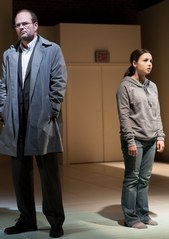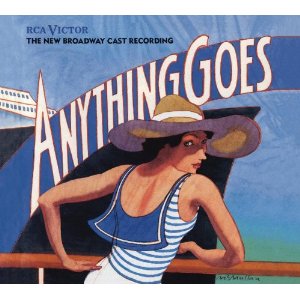SITE GUIDE
SEARCH
REVIEWS
REVIEW ARCHIVES
ADVERTISING AT CURTAINUP
FEATURES
NEWS
Etcetera and
Short Term Listings
LISTINGS
Broadway
Off-Broadway
NYC Restaurants
BOOKS and CDs
OTHER PLACES
Berkshires
London
California
New Jersey
DC
Philadelphia
Elsewhere
QUOTES
TKTS
PLAYWRIGHTS' ALBUMS
LETTERS TO EDITOR
FILM
LINKS
MISCELLANEOUS
Free Updates
Masthead
A CurtainUp Review
What Rhymes with America
By Elyse Sommer
|
"Hank have you ever noticed that as the list of things that Donít Matter grows the list of things that
Do Matter shrinks and while you would like of course to focus on the smaller list
you are distracted by the dull luster of the larger one"
— Sheryl |

Chris Bauer &Aimee Carrero
(Photo: Kevin Thomas Garcia) |
Her latest, What Rhymes With America, adds a 17-year-old to the mix of forty somethings. The main story line does in fact revolve around that young girl's unwillingness to connect directly with her father. And while the play's four actors are all in tune with Gibson's rhythms and word play, Aimee Carrero is particularly impressive in her Off-Broadway debut as Marlene. Carrero's expressive face is like the picture that's worth a thousand words, though she delivers the words Gibson has written for her with clarity and feeling. She also gets to sing the songs which have become something of a standard addition to a Gibson play.
The play begins and ends with Madeleine and Hank, her father (Chris Bauer, an Atlantic Theater regular who's also well-known to fans of HBO's True Blood ). In the first scene she refuses to let him into the apartment where she lives with Gina, her much mentioned but never seen mother who's kicked him out. Hank, still loves his wife and wants Marlene to act as a go-between for a reconciliation. This quite understandably makes her uncomfortable and even more fed up with what's going on in her life. As she sums it up "Iím pretty much seventeen Iím home alone I go to school alone I cross the street alone I think my thoughts alone I dread alone/ I dream alone."
Besides being forced to reject Hank out of loyalty to the parent she lives with, Marlene has an unrewarding volunteer gig at a hospital that's so understaffed that she feels they wouldn't even notice if she started operating. What's more, though she's volunteered mainly to enhance her college eligibility, the current family finances make it unlikely that she can afford a good college. (her unpaid allowance from Hank totals a hefty $240).
By the time the play ends with essentially the same scene we know a lot more about father and daughter. While Marlene isn't exactly screw-up proof, she turns out to be the play's most realistic character with the best possibility for getting her act together. As for Hank, he truly is a major screw-up. He's an economist who's gambled disastrously with his wife's savings, and whose research projects have apparently proved so unsatisfactory as to cost him his job. No wonder his wife is angry at him and wants him out of her life.
The play's two additional characters add considerable humor. They also round out Gibson's four-way portrait of people who discover that their lives aren't likely to be lived at the top of the chancy game of life.
It's when Hank pursues Marlene at her hospital job that he meets Lydia (Seana Kofoed, another Atlantic theater veteran), the oddball daughter of a man who has just died on Marlene's watch. Their conversation triggers a hilarious date. It's his first in twenty-three years and she hasn't exactly been a woman on the town either.
When the geeky looking economist assumes his unlikely role as a supernumenary he shares cigarettes and confidences with Sheryl (Da Vine Joy Randolph). Sheryl who envisioned a real acting career rather than being a non speaking extra donning Viking costumes sums up her life as so much "pleather." She ruminates on the list of "things that Donít Matter" growing while "the list of things that Do Matter" shrinking. Clearly another character who's reached that point in life where dreams have a way of not coming true — or, to cite a character from Gibson's last play This , "What if you wake up and discover you've been living a dinky life. . .like when you're in the middle of telling someone a story and as you're telling it say midway through you realize your story isn't as good as you thought it was but it's too late to go back."
Gibson has been blessed by having all her plays smartly and inventively directed by Daniel Aukin. Set designer Louisa Thompson, who also energized the previous production we reviewed, isn't on hand for the Atlantic Theater production. But no worries. Laura Jellinek has created an abstract set with just enough details to accommodate the various locations and and the way Aukin has the characters move almost soldier-like from one space to another — visually supporting the symbolism of round pegs trying to fit into squares.
In case you're wondering about the title which sounds less obscure than sic and r This, the questioning title IS mentioned. However, like life's vagaries, it eludes a simple explanation, so why not just see this play in which so little and yet so much happens and try to figure it out for yourself.
|
What Rhymes with America by Melissa James Gibson Directed by Daniel Aukin Cast: Chris Bauer (Hank), Aimee Carrero (Marlene), Seana Kofoed (Lydia) and DaíVine Joy Randolph (Sheryl) Scenic design: Laura Jellinek Costume design: Emily Rebholz Lighting design: Matt Frey Original music and sound design: Ryan Rumery Stage Manager: Kyle Gates Running Time: 90 minutes without an intermission Atlantic Theater Company 336 West 20th Street From 11/19/12; opening 12/12/12; closing 12/30/12. Tuesday-Saturday at 8pm, Saturday at 2pm, Sunday at 3pm and Sunday at 7pm. Wednesday matinees at 2pm on December 19 and December 26. No Sunday 7pm performances on December 9 and December 23. All tickets are $70. Reviewed by Elyse Sommer at December 8th press preview |
|
REVIEW FEEDBACK Highlight one of the responses below and click "copy" or"CTRL+C"
Paste the highlighted text into the subject line (CTRL+ V): Feel free to add detailed comments in the body of the email. . .also the names and emails of any friends to whom you'd like us to forward a copy of this review. Visit Curtainup's Blog Annex For a feed to reviews and features as they are posted add http://curtainupnewlinks.blogspot.com to your reader Curtainup at Facebook . . . Curtainup at Twitter Subscribe to our FREE email updates: E-mail: esommer@curtainup.comesommer@curtainup.com put SUBSCRIBE CURTAINUP EMAIL UPDATE in the subject line and your full name and email address in the body of the message. If you can spare a minute, tell us how you came to CurtainUp and from what part of the country. |

Slings & Arrows- view 1st episode free
 Anything Goes Cast Recording
Anything Goes Cast RecordingOur review of the show
 Book of Mormon -CD
Book of Mormon -CDOur review of the show

